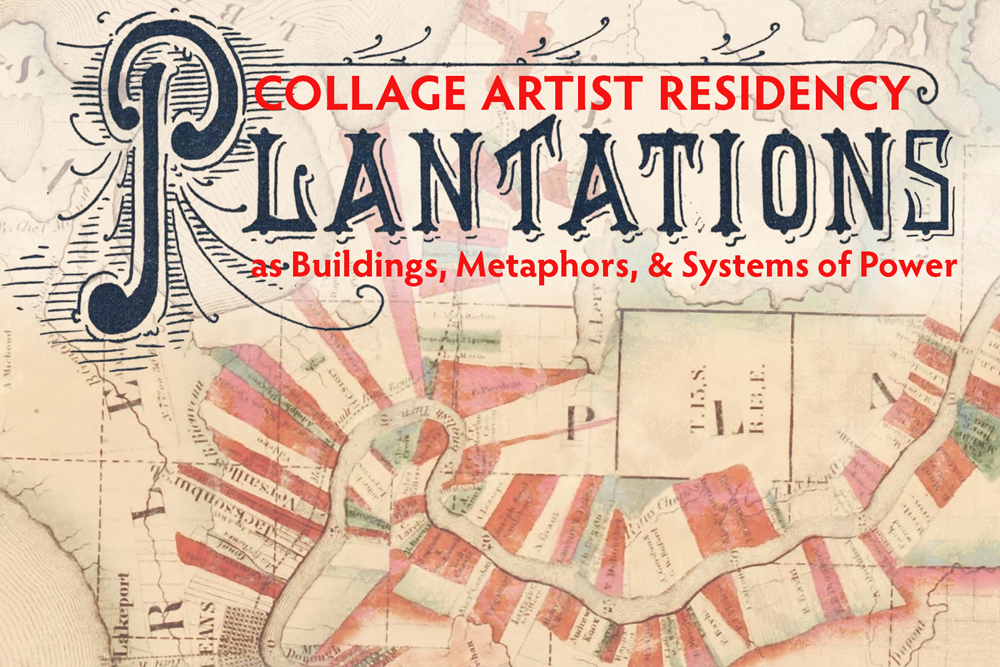
RESIDENCY ANNOUNCEMENT
Collage Artist Residency: Plantations as Buildings, Metaphors, and Systems of Power
at Kolaj Institute
13-17 October 2024
A five-day, in-person collage artist residency in New Orleans
About the Residency
As part of a year-long investigation of castles as buildings, metaphors, and systems of power, Kolaj Institute will host a week-long artist residency focused on Plantations. Pre-20th century industrial agriculture in the Southern United States was organized by plantations, single crop farms that used forced labor to grow commodities that were sold on to global markets. Lost Cause historical narratives have cast these sites in a Romantic light as beacons of genteel Southern culture, but a more honest review of the historical narrative shows them to be sites of torture and imprisonment, sources of trauma. While some historians have viewed plantations as race-based feudal systems, others have worked to create more complex narratives that explain the forced migration and enslavement of millions of Africans. The story of Slavery has been widely explored in popular media and art, but the systems of power and labor created post-emancipation have received little attention.
Proponents of celebratory history wish to remember a time of social order, but as Allen C. Guelzo wrote in Fateful Lightning: A New History of the Civil War and Reconstruction, “Alongside the Romantic image of magnolias at midnight lay a relentless economic rationality; alongside the facade of racial reciprocity lay resistance and revolt; and alongside the casual tolerance of slave labor in producing their most lucrative commodity, Southerners displayed a fierce personal independence and a resentment at condescension and control. Southerners veered between assertions that theirs was a thoroughgoing slave society, in which ‘every fibre…is so interwoven with it, that it cannot be abolished without the destruction of the other,’ and realizations that Southerners were as much participants in a liberal democratic order as any other Americans, though one inexplicably incorporating the quirk of slave labor.” The interwoven threads of Plantation culture did not end with the Emancipation Proclamation. How these threads were rewoven informs American society as we know it today. What role can artists play in making this history understood?
During this residency, collage artists come to New Orleans and explore the history of Plantations and learn how to adapt their artist practice to pick up the unfinished work of history and make art that contributes to the civic discourse. Through interactive sessions, visits to plantations, and collaborative collage making, artists will explore their process and practice; present a slideshow of their work; receive supportive, critical, curatorial feedback about their ideas; and discuss contemporary issues.
The residency speaks to issues of appropriation, copyright, and fair use and explore how the artist’s choice and understanding of material shapes the narrative of the artwork. Over the course of the week, artists will be challenged to make a single artwork (or small study for an artwork) that speaks to a larger body of work. Artists will leave the residency with a new perspective on their art practice.
Participants will view the artwork in the exhibition, “Temporal Geolocation: How Place & History Form Identity in Collage” on view at Kolaj Institute Gallery and consider the strategies artists used to include or speak to history, place, and identity in their work. Participants will visit the Laura Plantation and the Whitney Plantation with an eye towards how the history is told. Ric Kasini Kadour will present a curatorial framework for the project. Jeanna Penn will present on how she uses history and archives in her practice. At the end of the Residency, artists will present a single artwork (or small study for an artwork) that speaks to a larger body of work and the themes they want to explore.
After the Residency, artists will be invited to propose artwork for inclusion in Kolaj Institute’s Castle Project, an exhibition, book, and related programs in 2025-2026 that invite viewers to consider how the history of castles, colonies, plantations, and corporations relate to one another and shape the world we live in today.
PARTICIPATING ARTISTS
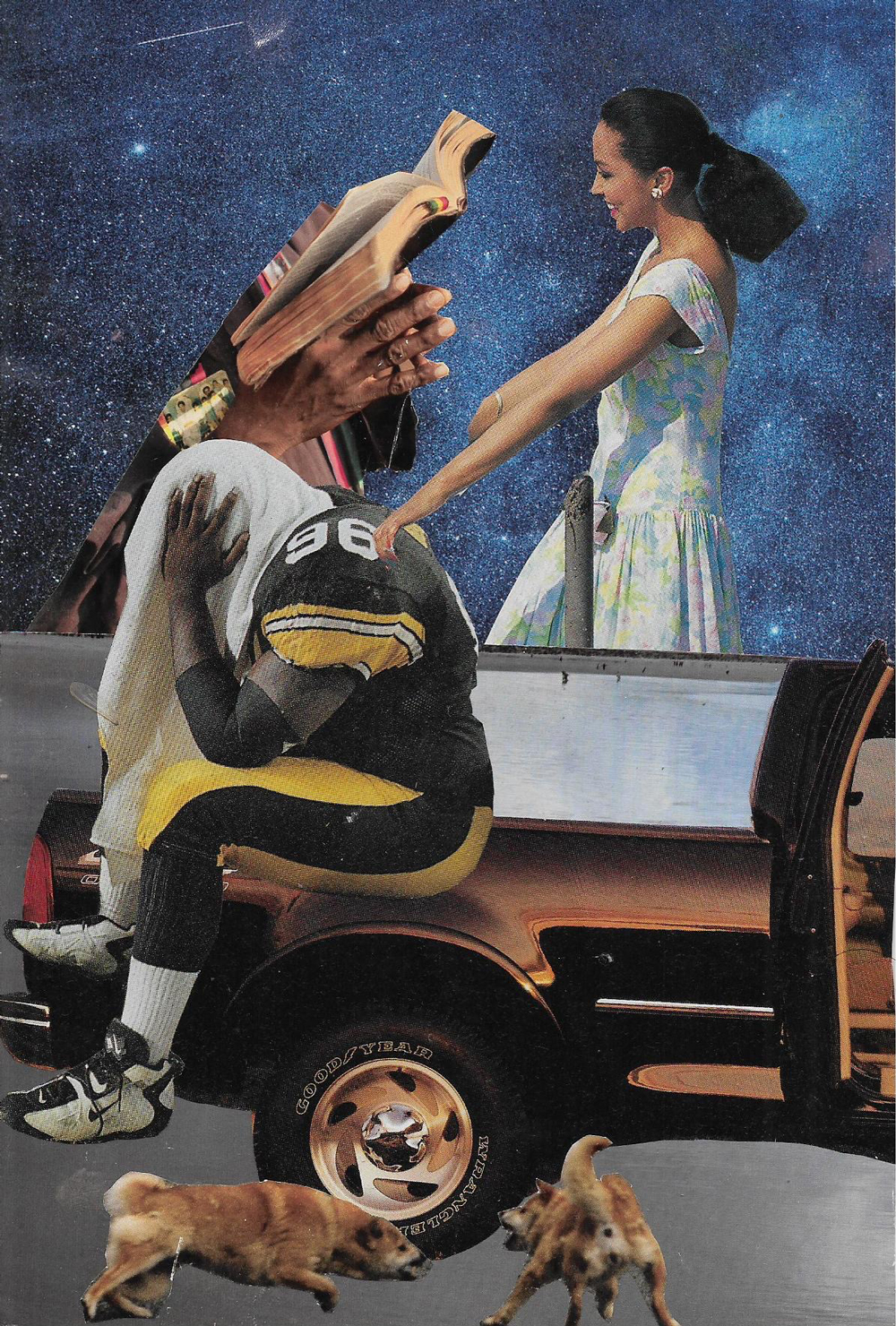
dimensions variable; collage; 2024. Courtesy of the artist.
Tyler “Ty” Allen holds an MFA from Pratt Institute and a BFA from Texas Southern University. His work explores the many layers that exist within the Black Experience. Utilizing varied media, he shows how Blackness isn’t a monolith, but instead exists on a broad spectrum influenced by an array of cultural and global influences. He emphasizes the uniqueness and beauty within Black culture, while paying close attention to the historical relevance of eras both past and contemporary. Pulling from media that range from sports and popular culture to historical and personal archives and journalistic media to back his stances on Black culture and its influence. The artist lives and works in Houston, Texas. Learn more on Instagram @typabloooo.
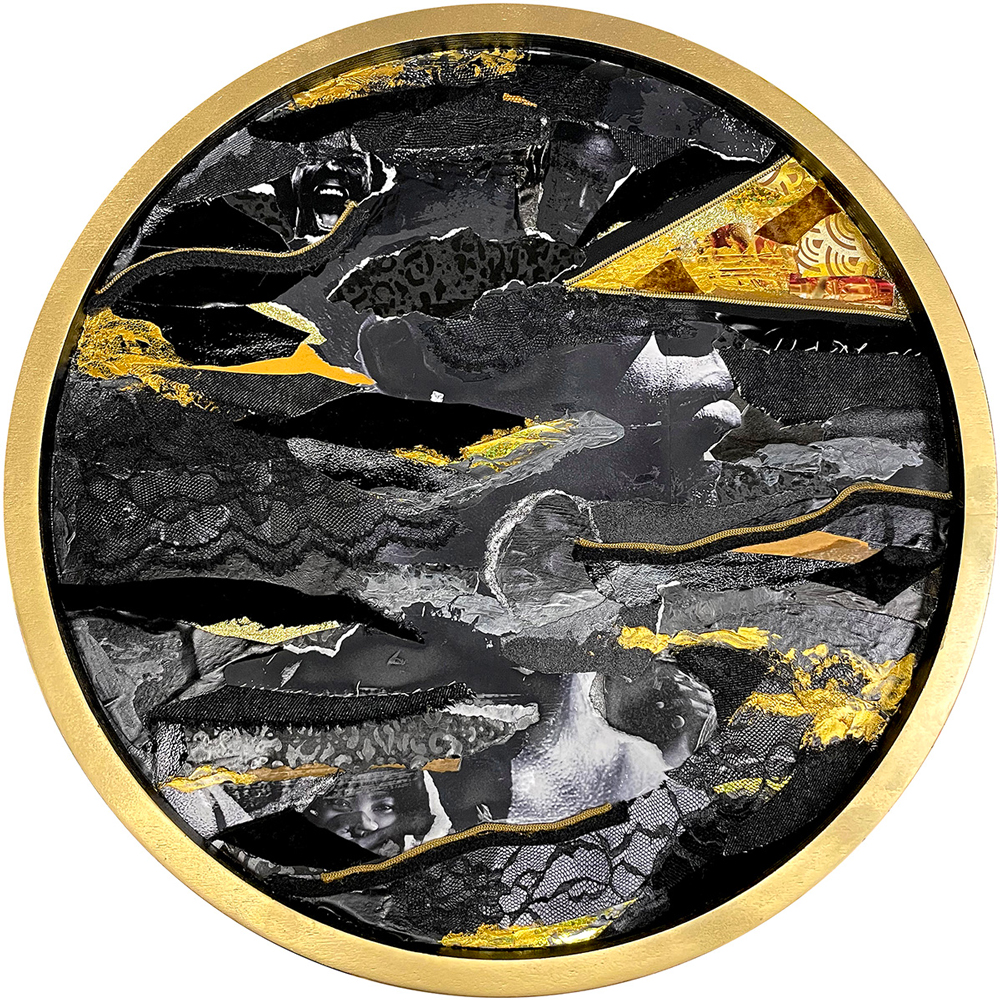
22″ diameter; various papers, twine, fabric, zippers, and acrylic on wood panel; 2024. Courtesy of the artist.
Rashad Ali Muhammad is a Maryland and Virginia-based interdisciplinary artist. He is a resident artist at the Torpedo Factory Art Center in Alexandria, Virginia and was the 2023 Art and Peacebuilding Fellow with the Carter School for Peace and Conflict Resolution at George Mason University. As a queer individual of the African Diaspora, Muhammad uses his art to dismantle societal binaries and foster liberation. His creative endeavors construct sanctuaries of healing and rejuvenation amidst the world’s turbulence, inviting viewers to embark on a journey of introspection and empathy. His artwork has appeared in print and digital media, including The Washington Post, Kolaj Magazine, Create! Magazine, and British GQ. Learn more at www.ramcreates.com.
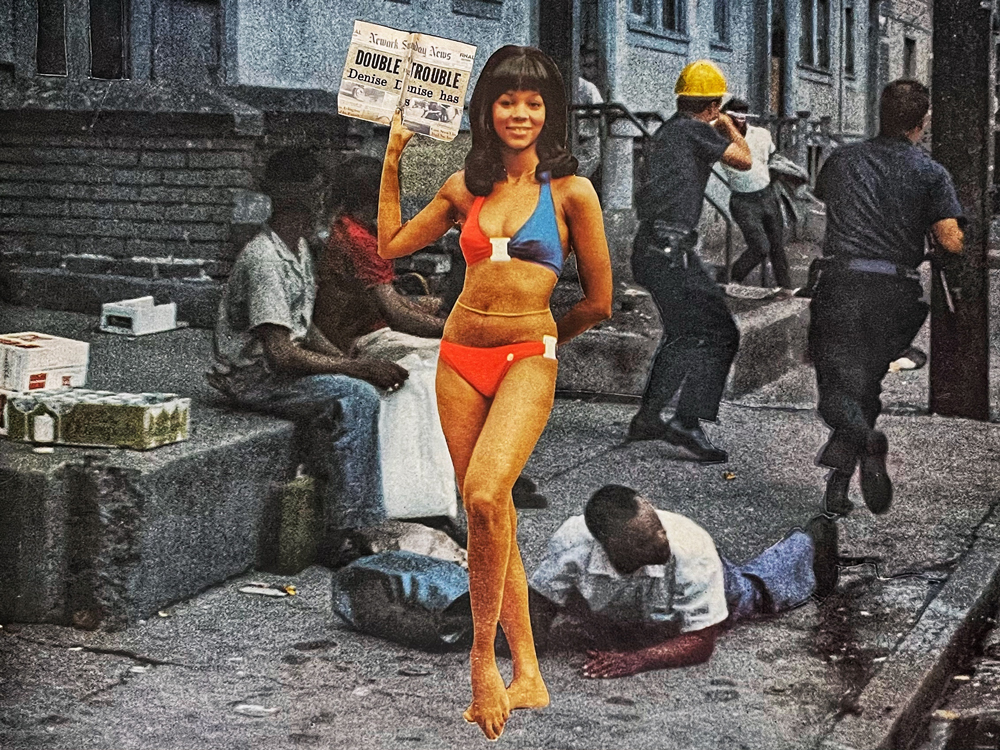
12″x16″; analog collage on cold press; 2023. Courtesy of the artist.
Alicia Saadi is a multi-disciplinary artist whose current focus is collage. Born at the end of a turbulent era, her work often references the civil unrest whose aftermath colored her childhood, as well as the stereotypical images of womanhood that prevailed then. Saadi holds a degree in art history which informs her content, while her studio practice is largely self-taught. She resides on the East Coast of the U.S. and has exhibited her work regionally. Learn more in the Kolaj Magazine Artist Directory and at www.aliciasaadi.com.
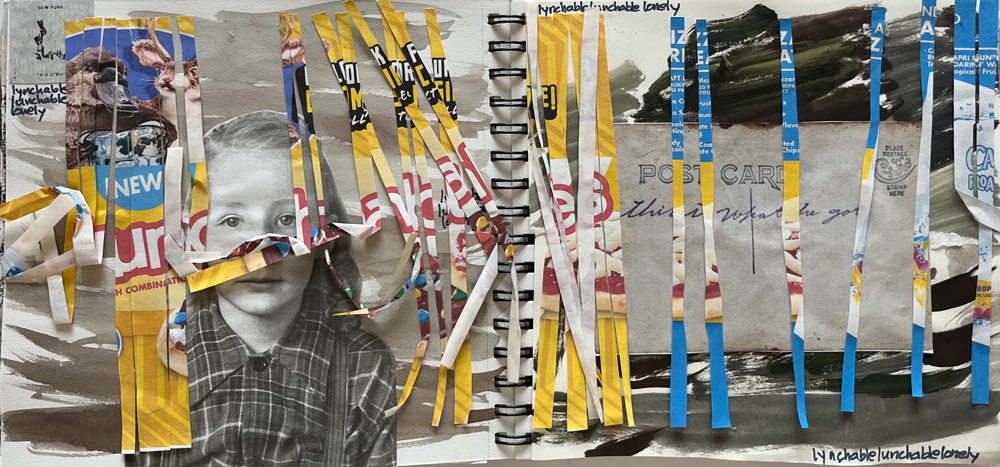
left page of White Supremacy ABC: found photo, online image of lunchable package, online image of handwritten postcard of lynching, acrylic paint; 2024. Courtesy of the artist.
Collagist Karin Williams lives in the Rio Grande Valley of central New Mexico on Piro land. She began using collage in the 2000s as an element of Visual Journaling as taught by Juliana Coles, an artist in Albuquerque, and found it was a way to uncover what was hidden. She has also studied Miksang photography and Ikebana, both dharma art practices in the context of Buddhist philosophy. Her work illustrates and attempts to metabolize her experience of growing up insulated in white supremacy culture. Williams’ artwork imagines antidotes to white supremacy in the language of shrines and altars.
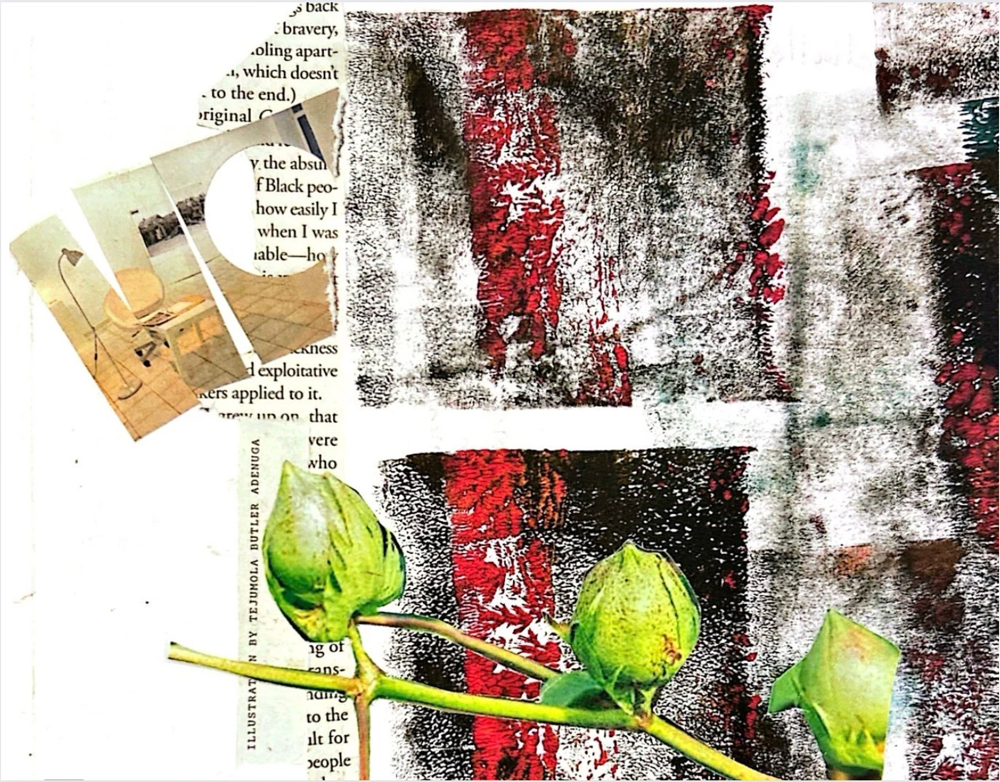
7″x12″; acrylic paint and collage on paper; 2024. Courtesy of the artist.
Jennella Young is a painter, mixed media, and book artist who lives and works in Brooklyn, New York. She is inspired by artists like Lynette Yiamdom Boakye and Stephanie LeDoux who do figure drawings and portraits of people of color in everyday genre scenes–somehow finding ways to make them magical. As a Black Caribbean American woman, she has a deep connection to art and literature that employ magical realism. These forms of expression tell complex beautifully operatic recreations of the history of the Caribbean and colonization while also elevating the voices and lost stories of women. Learn more on Instagram @jennebella.
ABOUT THE FACULTY
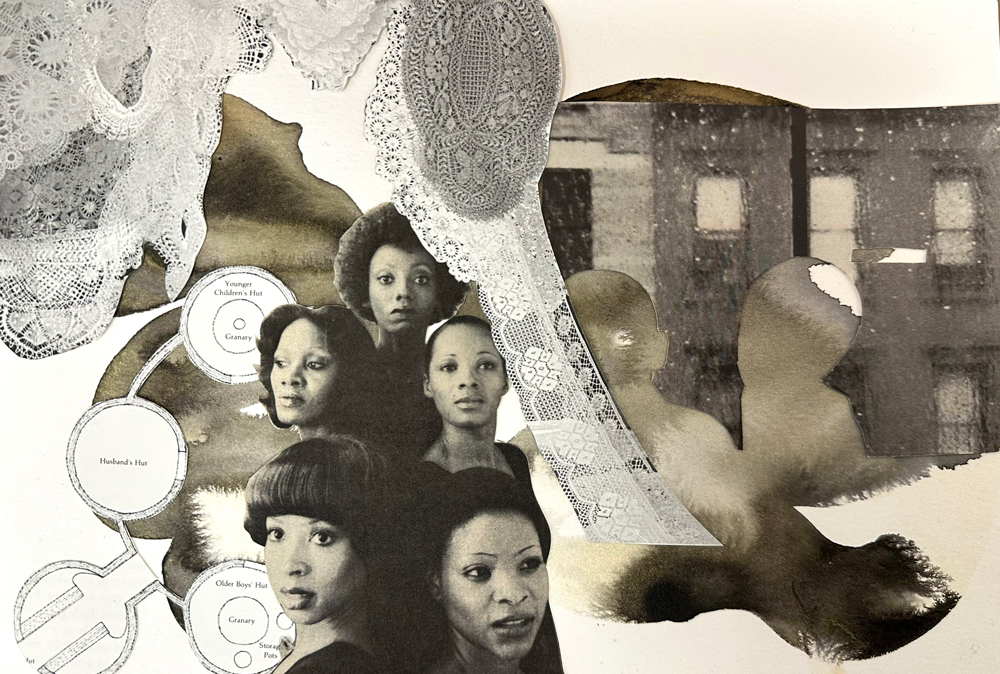
8″x12″; watercolor, India ink, acrylic, sourced imagery on watercolor paper; 2024. Courtesy of the artist.
Jeanna Penn is a contemporary artist who lives and works between Oakland and Los Angeles, California. She has been creating art for over twenty-five years in various forms including mixed media collage, soft sculpture, photography, zines and documentary film. Much of Jeanna’s work is centered around recontextualizing found imagery and documenting material histories. She received her BA in African American Studies from Morgan State University and continued graduate work in African History at Howard University and Historical Documentary Filmmaking at George Washington University. Jeanna’s work has been shown at the Arts Guild of Sonoma; The Art Cave in Santa Cruz; The Barrett Art Center; Eyelevel Centre; Jennifer Perlmutter Gallery; Delaplaine Arts Center; Smith Gallery of Yale Divinity School; 516 Arts; and the Henry Sheldon Museum of Fermont History. Her work has been featured in Create Magazine, Albuquerque Journal, Kolaj Magazine, and Hyperallergic. In addition to several private collections, Jeanna’s work is also a part of the San Francisco Museum of Modern Art’s permanent collection. INSTAGRAM
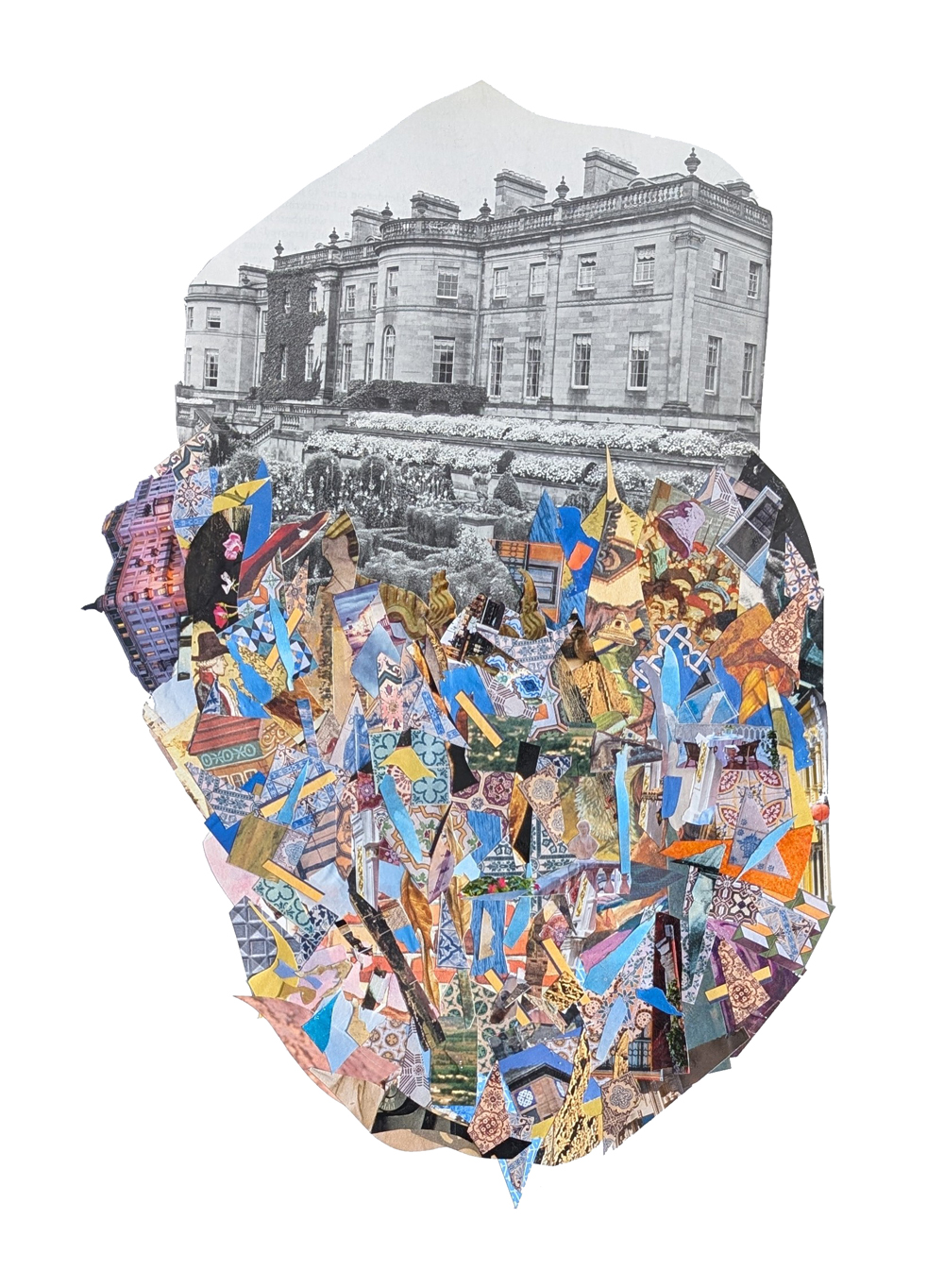
15″x11″; collage of book image and materials left behind by artists in residence on cardstock; 2024. Courtesy of the artist.
Ric Kasini Kadour, a 2021 Andy Warhol Foundation for the Visual Arts Curatorial Fellow, is a writer, artist, publisher, and cultural worker. Working with the Vermont Arts Council, Kadour curated four exhibits: “Connection: The Art of Coming Together” (2017) and Vermont Artists to Watch 2018, 2019 and 2020. In 2017, he curated “The Art of Winter” at S.P.A.C.E. Gallery in Burlington, Vermont. In 2018, Kadour curated “Revolutionary Paths: Critical Issues in Collage” at Antenna Gallery in New Orleans, which bought together collage artists whose work represents the potential for deeper inquiry and further curatorial exploration of the medium; followed in 2019 by “Cultural Deconstructions: Critical Issues in Collage” at LeMieux Galleries in New Orleans, which furthered the conversation; and “Amuse Bouche”, also at LeMieux Galleries in 2023. Since 2018, he has produced Kolaj Fest New Orleans, a multi-day festival & symposium about contemporary collage and its role in art, culture, and society. As Curator of Contemporary Art at Rokeby Museum in Ferrisburgh, Vermont in 2019 and 2020, he curated three exhibitions, “Rokeby Through the Lens” (May 19-June 16, 2019), “Structures” (August 24-October 27, 2019), and “Mending Fences: New Works by Carol MacDonald” (July 12-October 25, 2020). He also curated “Contemporary American Regionalism: Vermont Perspectives” (August 17-October 20, 2019); “Where the Sun Casts No Shadow: Postcards from the Creative Crossroads of Quito, Ecuador” (November 1-30, 2019); and “Many Americas” (August 20-November 27, 2022) in the Wilson Museum & Galleries at the Southern Vermont Arts Center. “The Money $how”, co-curated with Frank Juarez, was presented at the AIR Space Gallery at Saint Kate-The Arts Hotel in Milwaukee, Wisconsin (April 10-September 12, 2021). For Birr Vintage Week & Arts Festival in Birr, County Offaly, Ireland (August 13-20, 2021), he curated “Empty Columns Are a Place to Dream”, which traveled to the Knoxville Museum of Art in January-February 2022. At 516 ARTS in Albuquerque, New Mexico, Kadour co-curated with Alicia Inez Guzmàn two exhibitions: “Many Worlds Are Born” (February 19-May 14, 2022) and “Technologies of the Spirit” (June 11-September 3, 2022). In 2023 at the Knoxville Museum of Art, Kadour curated “Where the Sun Casts No Shadow: Postcards from the Creative Crossroads of Quito, Ecuador” (January 9-February 16, 2023) and “Mythical Landscape: Secrets of the Vale” (March 17-May 28, 2023). In September 2023, he curated “Word of Mouth: Folklore, Community and Collage” at A’ the Airts in Sanquhar, Scotland. His first short film, The Covenant of Schwitters’ Army, debuted at Collage on Screen during Kolaj Fest New Orleans 2023. His second, Joy Is Paper, debuted at Collage on Screen during Kolaj Fest New Orleans 2024. Kadour is the editor and publisher of Kolaj Magazine. He has written for a number of galleries and his writing has appeared in Hyperallergic, OEI, Vermont Magazine, Seven Days, Seattle Weekly, Art New England (where he was the former Vermont editor) and many others. Kadour maintains an active art practice and his photography, collage, and sculpture have been exhibited in and are part of private collections in Australia, Europe and North America. In January-February 2020, he was artist-in-residence at MERZ Gallery in Sanquhar, Scotland. He holds a BA in Comparative Religion from the University of Vermont. Kadour splits his time between Montreal and New Orleans. www.rickasinikadour.com
